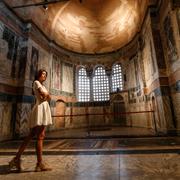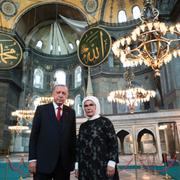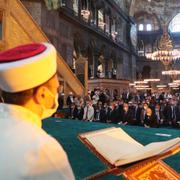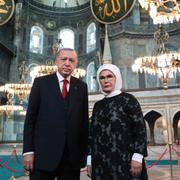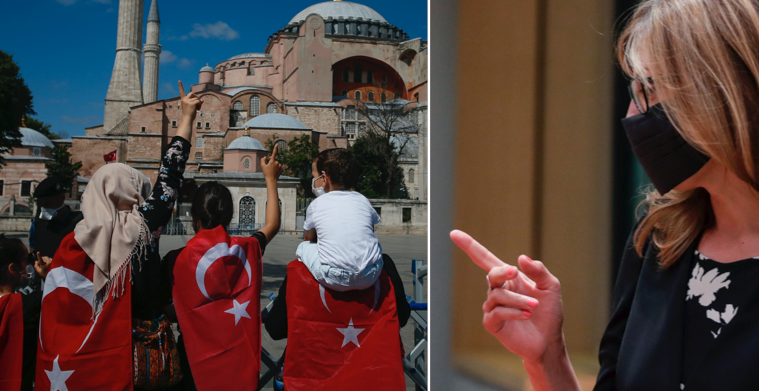
EU-länderna fördömer Turkiet för Hagia Sofia
Samtliga EU:s utrikesministrar fördömer Turkiets president Erdogan för hans beslut att omvandla Hagia Sofia till en moské, rapporterar AFP. Under måndagen träffades ministrarna i Bryssel och Turkiet var i fokus under samtalen.
Turkiets inblandning i konflikten i Libyen och borrandet efter olja och gas utanför Cypern oroar också ministrarna.
EU har sedan 2016 varit beroende av att Turkiet hindrar migranter från att komma in i Europa. Den tyska utrikesministern Heiko Maas säger till AFP att Turkiet har en strategisk betydelse för EU och att det är av största vikt att dialogen mellan dem fungerar.
bakgrund
Hagia Sophia
Wikipedia (en)
Hagia Sophia (; from the Koinē Greek: Ἁγία Σοφία, romanized: Hagía Sophía; Latin: Sancta Sophia or Sancta Sapientia, 'Holy Wisdom'), officially the Great Mosque of Ayasofya (Turkish: Ayasofya-i Kebir Camii Şerifi), and formerly the Church of Hagia Sophia is a Late Antique place of worship in Istanbul that has served as a Greek Orthodox Christian patriarchal cathedral, briefly a Roman Catholic cathedral, later an Ottoman mosque, and a museum. Completed in 537, during the reign of the eastern Roman emperor Justinian I, it was then the world's largest interior space and the first to employ a fully pendentive dome. It is considered the epitome of Byzantine architecture and is said to have "changed the history of architecture". It is also an important example of the Islamic practice of converting non-Islamic places of worship into mosques, which has led to conflicts and religious strife in several parts of the world.Built as the Christian cathedral of Constantinople between 532 and 537 on the orders of Justinian I, the basilica was designed by the Greek geometers Isidore of Miletus and Anthemius of Tralles. The present Justinianic building was the third church of the same name to occupy the site, the prior one having been destroyed in the Nika riots. Episcopal see of the ecumenical patriarch of Constantinople, it remained the world's largest cathedral for nearly a thousand years, until Seville Cathedral was completed in 1520. In 1204, it was converted by the Fourth Crusaders to a Roman Catholic cathedral under the Latin Empire, before being restored to the Eastern Orthodox Church upon the return of the Byzantine Empire in 1261. After the Fall of Constantinople to the Ottoman Empire in 1453, it was converted to a mosque. In 1935, it was secularized into a museum. In early July 2020, the Council of State annulled the Cabinet's 1934 decision to establish the museum, revoking the monument's status and a subsequent decree of the President of Turkey ordered the reclassification of Hagia Sophia as a mosque, a controversial move that has invoked condemnation from the World Council of Churches and many international leaders.The church was dedicated to the Wisdom of God, the Logos, the second person of the Trinity, its patronal feast taking place on 25 December (Christmas), the commemoration of the birth of the incarnation of the Logos in Christ. Sophia is the phonetic spelling in Latin of the Greek word for wisdom and although sometimes referred to as Sancta Sophia, 'Saint Sophia', it is not connected with Sophia the Martyr. The centre of the Eastern Orthodox Church for nearly one thousand years, the building witnessed the excommunication of Patriarch Michael I Cerularius officially delivered by Humbert of Silva Candida, the papal envoy of Pope Leo IX in 1054, an act that is commonly considered the start of the East–West Schism. The doge of Venice who led the Fourth Crusade and the 1204 Sack of Constantinople, Enrico Dandolo, was buried in the church.
In 1453, Mehmed the Conqueror ordered the cathedral's conversion into a mosque. The patriarchate moved to the Church of the Holy Apostles, which became the city's cathedral. Although some parts of the city had fallen into disrepair, the cathedral had been maintained with funds set aside for this purpose, and the Christian cathedral made a strong impression on the new Ottoman rulers who conceived its conversion. The bells, altar, iconostasis, ambo and baptistery were removed and relics destroyed. The mosaics depicting Jesus, his mother Mary, Christian saints, and angels were eventually destroyed or plastered over. Islamic architectural features were added, such as a minbar (pulpit), four minarets, and a mihrab – a niche indicating the direction of prayer (qibla). From its initial conversion until the construction in 1616 of the nearby Sultan Ahmed Mosque, aka the Blue Mosque, it was the principal mosque of Istanbul. The Byzantine architecture of the Hagia Sophia served as inspiration for many other Ottoman mosques, including the Blue Mosque, the Şehzade Mosque, the Süleymaniye Mosque, the Rüstem Pasha Mosque and the Kılıç Ali Pasha Complex.
The complex remained a mosque until 1931, when it was closed to the public for four years. It was re-opened in 1935 as a museum by the secular Republic of Turkey. Hagia Sophia was, as of 2014, the second-most visited museum in Turkey, attracting almost 3.3 million visitors annually. According to data released by the Ministry of Culture and Tourism, Hagia Sophia was Turkey's most visited tourist attraction in 2015 and 2019.
Omni är politiskt obundna och oberoende. Vi strävar efter att ge fler perspektiv på nyheterna. Har du frågor eller synpunkter kring vår rapportering? Kontakta redaktionen
